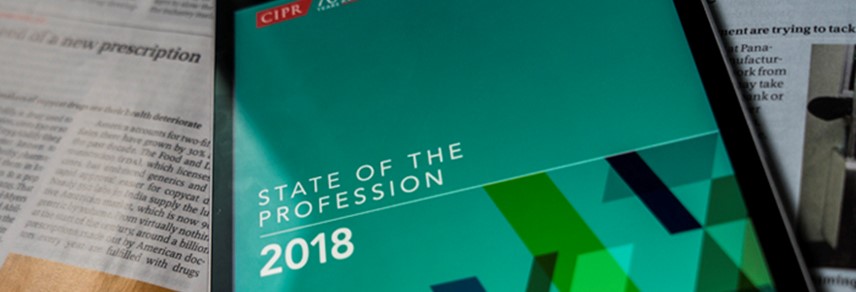
CIPR RELEASES 'STATE OF THE PROFESSION' 2017/18 REPORT
As technology develops, communications advances and the function of PR ceases to exist in a silo. As a result, expectations on and of PR professionals has changed. From recruitment issues such as skills and salaries, to topical subjects surrounding diversity and the gender pay gap, the state of the PR profession in 2018 is arguably more volatile than ever before.
Since 2009, the Chartered Institute of Public Relations (CIPR) has collected data from those working in public relations to inform its ‘State of the Profession’ report. As the largest communications-focused trade body working outside North America, the report is usually formed from CIPR member insight. This year, new collection methods and collaboration with reputation and marketing consultancy Chalkstream see a methodological approach and wider practitioner data pool lead to detailed insight unsurpassed by previous years.
Described as ‘ground breaking’ by Ben Verinder, founder and managing director of Chalkstream, the ‘State of the Profession’ 2017/18 report offers intelligent insight fuelled by a much wider pool of respondents. How the PR industry responds to changes on a wider global context informs much of this year’s findings.
“For the first time we have used occupational data from the Office for National Statistics (ONS) to help develop our understanding of the population of PR practitioners across the UK,” says Verinder. “When we compare this data set against the outcome of the ‘State of the Profession’ 2017/18 survey, we can see how the survey results are representative of the broader PR population.”
For Chalkstream and the CIPR, garnering insight from a wider sample was paramount if this year’s ‘State of the Profession’ is to influence the continued development of the public relations industry. Key findings included recognition that overall pay has risen, but there remains a significant bridge between male and female earnings – despite the disparity between men and women in the profession. A lack of innovation regarding inclusion is also echoed in acknowledgement of the industry’s failing towards diversity, which remains at an estimated 87% white. With less than one in ten PR industry professionals identifying as BAME, the industry is hugely unreflective of the approximately 31.4% of primary school pupils that identify in the same way. Analysis through census data thus situates the public relations industry into a broader demographic context, illustrating those areas in which the profession is underperforming.
On the other hand, the ‘State of the Profession’ 2017/18 indicates that PR is increasingly recognised as a strategic management function. Historically a turbulent area, communicators still struggle to achieve representation at boardroom level. This is exacerbated through a 63% to 36% female/male ratio which sees a lack of women sitting on UK boards more broadly. However, the report also highlights a growing diversity in the skillset of public relations professionals. It acknowledges that honing diverse talent such as in editorial and marketing is symptomatic of the wider shift towards more fully integrated communications function.
For Sarah Hall, CIPR president, the report highlights much of what the UK public relations industry can be proud. However, true insight exists to highlight those areas in which the profession has room to grow and develop, she says, which also shows how the CIPR can be more involved.
“Practitioners remain predominately tactical,” says Hall. “The CIPR’s role must be to equip them with boardroom skills. By focusing on financial, business management and consultancy competencies we can command the respect of management teams by speaking their language and by demonstrating the true value of public relations, increase investment in it.”
And, continues Hall, it is issues surrounding workplace wellbeing that truly represent the likely trajectory of the profession in the future. Amid the wider scrutiny surrounding business considering the recent gender pay gap legislation, the often female-dominated communications profession should act as a blueprint for other industries – both professionally and ethically.
“Of concern within the research is the increasing number of senior female professionals leaving the industry,” explains Hall. “This, coupled with the issue of the gender pay gap, merits further research. The increase of practitioners reporting a mental health condition is a reminder for us all that PR is a very demanding business – employee wellbeing and people-first strategies must always be prioritised.”
The ‘State of the Profession’ 2017/18 does indicate a move towards achieving a more inclusive environment from which communicators of all backgrounds can work and thrive. Contextualising the public relations profession amid the UK population offers a unique, socially-driven insight into how the industry can ensure future generations of employees are comfortable and welcomed in a profession influenced by change on all sides.
To view the full report, visit the CIPR website.
For more from Communicate magazine, follow us on Twitter @Communicatemag

